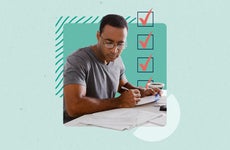How to get debt-free in a year

The Bankrate promise
At Bankrate we strive to help you make smarter financial decisions. While we adhere to strict , this post may contain references to products from our partners. Here's an explanation for .
A lot of people may find themselves up at night worried about how they’re going to pay their debts. If you’re one of them, you might be trying to figure out how to get out of debt as quickly as possible.
Not all debt is bad. If your debt increases your net worth or provides future value (like with a mortage), it’s usually good debt. However, if your debt doesn’t do this — and you don’t have enough cash on hand to pay it off — it’s bad. Furthermore, if you’re swimming in this bad debt, you might believe you’ll never pay it off.
Here’s the good news about bad debt. With careful planning, perseverance and a change in your spending habits, you can reduce and even pay off that debt. Depending on how much you owe and how much you can pay, you could be free from that debt morass in a year or less. While this won’t work for everyone because everyone’s circumstances are different, some people may be able to get debt-free through careful planning.
America’s debt problem
You’re not alone if you find yourself mired in debt. As of the fourth quarter of last year:
- Total household debt stood at $17.5 trillion.
- Credit card balances totaled $1.13 trillion.
- Mortgage balances were $12.25 trillion.
- Auto loan balances stood at $1.61 trillion.
A Bankrate study showed that 49 percent of credit card holders carry a credit card balance from month to month, increasing from 39 percent in 2021. With prices rising 20.4% since February 2020, it isn’t surprising that more people are carrying debt.
How to be debt-free in one year
Hoping your debt will disappear or praying for a monetary windfall is a lovely pipe dream. In reality, you can’t count on magically disappearing debt or sudden newfound riches. However, you can take steps to get out of bad debt through two steps: assessment and action.
While this debt payoff plan won’t apply to large debts like your mortgage or student loan, you can work on getting rid of bad debts that may be holding you back. If a year isn’t reasonable for your financial situation, consider choosing another clear timeframe to help you take meaningful action.
How to assess your debt to make a payoff plan
Assessment is a must when it comes to paying off your debt. You need to know your starting point before developing an action plan.
1. Know what you owe
You might be making only minimum payments on credit cards or loans if you feel like you can’t afford much more. If so, your attention is probably focused on staying afloat. You may not have a clear idea of the big picture.
The first thing to do is step away from the trees to view the forest. Gather all your credit card, mortgage and loan information. Record the balances for each, including principal and interest.
Knowing exactly how much can help you take the actions needed to eliminate debt quickly. With a total amount and a view of your monthly payments, you can see exactly what you’d need to pay each month to get rid of your bad debts in a year.
2. Examine your expenses
This is where you carefully analyze your “need to have” expenditures (like housing, utilities and food) vs. your “nice to have” expenditures (everything else). This careful evaluation can help you free up cash to pay down debt.
Maybe you don’t need that daily latte from the coffee shop down the street. Perhaps there’s a subscription to a newspaper or magazine you don’t read or a streaming service you don’t use frequently. Cutting back on these and other “nice to haves” might generate only a few dollars a month. Still, that’s a few dollars more you can direct toward credit card or loan payments.
3. Decide on your direction
There are two common approaches to paying off debt. People debate about which approach is best. Consider your financial circumstances and account balances to see which makes the most sene for you.
Snowball: Focus on small debt first.
Direct all efforts toward paying off small-balance debt. Once that credit card or loan is paid off, you roll the extra money into the next-smallest debt, and so on. Be sure you continue making the minimum payments on your other debts.
Paying off a lot of smaller accounts means you accrue more money. Like a snowball that grows when rolled down a hill, paying off smaller accounts means more money, which is rolled into paying off larger accounts. You get the benefits of quick wins from paying off smaller debts, but you may pay more interest on your other debts.
Avalanche: Pay attention to high-interest accounts.
Pay minimum balances on everything you owe except for the account with the highest interest rate or APR. Everything extra goes to that account. When it’s paid off, you use that extra money to pay the account with the next highest interest rate. The advantage is that you eliminate the most expensive debt first. Paying this debt off can take longer, especially if those accounts carry larger balances.
4. Evaluate additional tools
There are other methods you might consider when strategizing how to pay down your debt quickly:
- Debt consolidation: Use balance transfer credit cards, dedicated loans, home equity loans or cash-out refinance to help reduce what you owe.
- Credit counseling: Work with an accredited nonprofit credit counseling organization for help with budgeting and creating a realistic debt management plan.
- Financial advisors: Partner with an experienced debt-reduction advisor who can help you budget, pay off debt, and put what’s left over toward savings.
How to take action toward paying off debt
After carefully assessing your situation and options, you can take the action steps.
1. Keep a close watch
A well-crafted monthly budget is one of the most important tools in your arsenal for paying down debt.
This budget is your paper or computer trail, which tells you how much money you have and how much you’re directing toward those “need to have” expenses. More importantly, it tells you how much you’ll direct toward paying down those credit cards and loans.
2. Negotiate with creditors
Credit card companies and lenders want their money. If you make a good-faith effort to repay them, they might be willing to meet you halfway by reducing interest rates, late payment fees or other costs.
You can negotiate directly with these companies or get help from a credit counseling service. Some debt relief services also provide this service. If you decide to go this route, do your research to find a reputable organization. There are legitimate debt relief companies out there with the sole goal of helping you resolve what you owe. But other, sketchier companies might charge high upfront fees and give you poor advice that could ruin your credit score.
3. Automate payments
Automating payments to pay down debt relieves the stress of remembering payment due dates and reduces the potential for late fees. It also helps with money management, saves time and improves your credit score if you stick to the plan.
The important aspect of automatic payments is ensuring there’s enough in your account to pay your credit card or loan balance. An overdrawn account could generate unwelcome fees and extra costs.
4. Increase your income
The more money you earn, the more you can direct to paying down your debt. You might pick up additional hours at your job. Or take advantage of the gig economy. You can choose from many side hustles to add more money to your efforts.
5. Build emergency savings
Putting money toward an emergency fund while trying to pay down debt might seem counterintuitive. But an unexpected expense like an unanticipated car repair or medical bill can erode your efforts to become debt free. Without that extra financial cushion, you’ll be tempted to turn to — you guessed it — that credit card you’re trying to pay off.
Experts suggest an emergency fund should cover three to six months of salary. You might not be able to do that, so start small. Even putting aside a few dollars a day into an account can quickly add up.
6. Resist additional debt
When credit cards or personal loan solicitations arrive in the mail, tear them up. Also, avoid “buy-now-pay-later” installment loans. These can add unnecessary expense and interfere with your efforts to pay off what you already owe. The one exception to this is a zero-interest balance-transfer credit card to help with debt consolidation.
The bottom line
It is possible to get debt-free in one year or another reasonable timeframe. Doing so relies on the willingness to analyze what you owe, stick with a budget, cut unnecessary expenses and get help when needed.
In addition, don’t blame yourself for your current situation. You’re not terrible because you have bad debt. Instead, focus on solutions and celebrate small wins. These keep you motivated and help you move ahead toward a goal of financial stability.
Related Articles



